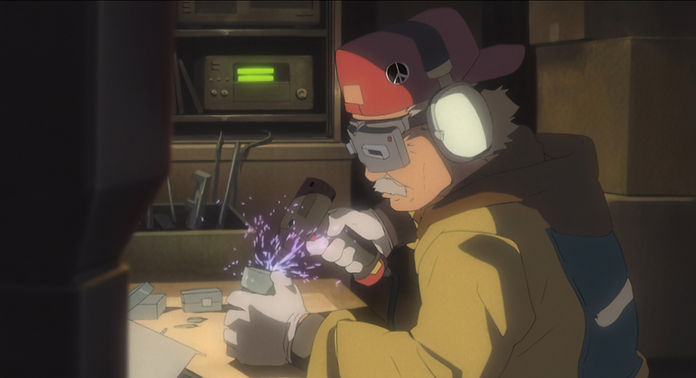
Additional Action Reports
This page contains all non-episode-specific action reports. Scroll down to see them all. Beware that some contain spoilers for the series, so please scroll and read with caution.
IGPX 101
IGPX History

The IGPX was founded in 2023. Prior to its inauguration, the most dangerous kind of races were those using robotic mechs, which were being developed in the field of robotics at the time. The mechs used in these races used wheels and had multiple arms and legs. With the growing popularity of these types of races, many organizations were formed, each of which held races with different rules for how they would run the races. Because they all had different rules, robots had special characteristic suited to each type of race, and the world watched as a new hobby was being unveiled. On the other hand, there were people who feared a decline in this type of robot racing due to the division of funds and spectators among all the different organizations. People then came up with an idea to make a kind of race where the fastest on-land battles would take place. Without diminishing the attractiveness of this idea, a plan was made to make this type of race accessible to everyone. To have the fastest and safest races was the goal of the IGPX.
The IGPX had officially started, and the first race was held in 2023 to celebrate its inception. At that time, mechs that looked like rockets with arms and legs attached simply circled an oval course. However, a few years later, humanoid form mechs similar to today's IG mechs appeared on the scene. The layout of the course was also changed to be more versatile, and gradually changed to a layout similar to that of the present-day course. A quarter of a century later, the IGPX has upheld a standard set out at its inauguration - holding the safest races. Even now, there are people who use the phrase, "Races of Immortals", based on the full name of the IGPX - The Immortal Grand Prix.
Now, let's introduce two pilots from the IGPX that nobody can forget!

The first is Ricky Perch. He is sometimes referred to as the father of the IGPX, as he was the one who helped popularize the IGPX shortly after its inception. There are a number of people who consider the 2027 race between Ricky Perch and Arrow Edison (also known as Con Edison) to be the most historic race in the IGPX. This race would decide the champion for that year, However, Ricky Perch died in a sudden accident during a practice run shortly after the race. After that, the Ricky Circuit was founded because Ricky's only win in his career was on that track, and even today the current IGPX track uses the Ricky Circuit as the basis for its design.


The second is Rocket George, also known as The Rocket or Rocket G. He was only in IG-1 for four years (from 2031-2035), but he always made it to the final race of every season, winning two of them. His beautiful and aggressive racing excited many fans and made the popularity of the IGPX worldwide unwavering, and became a major driving force behind its nickname "the world's fastest motorsport". But in his 5th year, he suddenly retired. Nobody knows what happened to him after he parted ways with the IGPX.
IGPX 201
Basics of the IGPX

Basic Rules
The IGPX is a race in which two teams compete against each other in three laps of a 60 km course. Each team is allowed to run a maximum of three mechs. Each mech has one pilot. Animal Navigation allows for an exception - an animal can also ride in the cockpit with a pilot. The points awarded for each position are 15 for first place, 7 points for second place, 5 for third, 3 for fourth, 2 for fifth and 1 point for sixth. The team that earns the most points is the winner of that race.

Lap-by-Lap Rules & Highlights
The first lap is called the performance lap, during which no battles with enemy mechs are allowed; the main objectives are to fight for position and get a feel for the course layout in order to gain an advantage in the battles that will take place after the first lap. Battles are not allowed until the second lap. The battles are the best part of the IGPX, where teams use their own unique formations and employ numerous tactics. In the third and final lap, teams are allowed to change to Speed Mode. The timing of the switch to Speed Mode, which reaches a maximum speed of 600 km/h, is a moment when teamwork is crucial, as it determines the outcome of the race. Pits (on-track inspections and parts replacements via Running Skeletons) are only allowed once for both teams. The timing of this declaration, which can only be made once per race, can change the dynamics of the race.

League Organization and Team Changes
The IGPX is organized in three leagues: the IG-1, the IG-2 and the IG-3. They allow 6, 12, and 48 teams to compete, respectively. In the IG-1 and IG-2, all teams compete in a round-robin tournament, with the top two teams competing in the finals after the Regular Season to determine the winner of that year's tournament. In the IG-3, each team competes in a total of 12 races according to the schedule set by the IGPX competition prior to the season, and the ranking is determined by the points earned by each team. The championship game is held only if the teams have the same number of points. At the end of each season, the results will be used to switch teams between the leagues, with the winner of the season from IG-2 being promoted to IG-1 and the loser of the season from IG-1 being relegated to IG-2. Similarly, the top three teams from IG-3 and the bottom three teams from IG-2 are swapped.
The Course and the Location

Course Layout
Currently, all IG-1 races are held on a dedicated circuit over 60 km in length built within IG City. A variable layout system allows the layout to be changed from one race to the next and also allows reconfiguration during the race. According to a fan survey conducted in 2047, the four most popular and exciting sections of the course are the following:
1. The Spiral: The section where the mechs enter that spins them around like a tornado, without sacrificing the mech's speed.
2. Revolution Tunnel: The section where the course surface becomes 360 degrees, allowing attacks from all directions.
3. The Homestretch: The section where fans can see the mechs fly at maximum speeds.
4. The Up-Down: The section where the fun of aerial combat can be seen.
Additionally, the "Valley Chicane" (located on Route 02), which has not been used effectively in recent years, is also popular because it is difficult to overtake enemy mechs even when the opportunity arises and requires a high level of piloting skill.
One final note regarding the course layout: teams are not informed of the layout of the course until 12 hours before they arrive at the Starting Grid. Since practice runs are not allowed after that, final adjustments to the IG mechs can only be made during that 12-hour period.
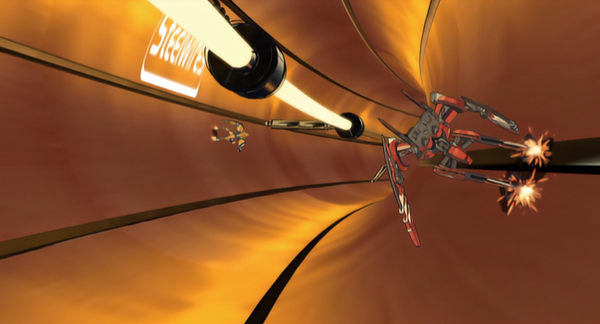



IG City
IG City is a city that was built and developed in the desert of Arizona in the US to host the IGPX. At the center of the city is a dedicated IGPX track, surrounded by huge buildings housing IGPX management headquarters and sponsor companies. At the core of the city is a base camp for registered teams and satellite offices of supporting companies, surrounded by research facilities of IGPX-related companies, entertainment facilities, and hotels where people can stay and then watch the races in person.

IGPX 301
IGPX Mech Characteristics Part 1
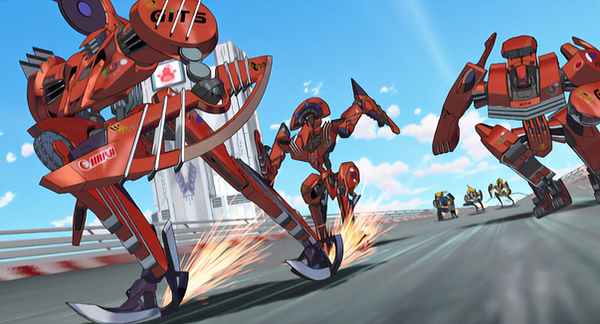
The Mechs' Power
Currently, each IG mech uses a hybrid system of an in-wheel hydrogen engine powered by fuel cells and an electric motor as its power source. The motor itself acts as a dynamic damper to absorb vibrations, resulting in very stable operation with almost no vibration felt by the pilots. Its dynamic performance and safety are demonstrated by the fact that there has never been an accident with these mechs, even when racing at average speeds of 400 km/h with sudden increases and decreases in power.

Three Main Configurations
Although IG mechs are limited to a maximum height of 7.5 meters, a maximum width of 5.2 meters, and a maximum weight of 3 tons, IG mechs have one key difference from other high speed races: their ability to change into different configurations. Many teams now use three modes of configuration: "Standard Mode," racing on two legs; "Battle Mode," which allows teams to begin using their Inner Edge abilities; and "Speed Mode," which allows each mech to achieve its maximum speed in order to reach the finish line as quickly as possible. The design and variety of these configurations, resulting from the transformative abilities of each mech, have helped to support the popularity of the IGPX.

Inner Edge
A mech's Inner Edge is essential in Battle Mode, but there are guidelines for its design: "The main unit of the Inner Edge must always be in contact with the mech and any external parts when in Speed Mode. This rule was made in order not to deny the possibility of all kinds of battles, while at the same time being a safety measure for Speed Mode. This is to prevent a catastrophe in case a mech comes in contact with something when the mech reaches its maximum speed.


Animal Navigation
One of the most creative features of the IGPX Regular Season is the Animal Navigation System. This is a system that allows pilots with animal sensitivity to ride their mechs with pre-registered animals. Developed by ISHIGAKI, which currently provides the base operating system for IG mechs, the Animal Navigation System allows the instincts of the animals on board (instantaneous coping and orientation control) to be fed back to the machine. However, it can be difficult for teams to choose not only the right pilot but also the right animal as their Animal Navigation partner. Currently, only 7 out of 66 teams are registered to use the Animal Navigation System. Additionally, there have only ever been not more than two teams using the system in any given season (this is the case for both the 2048 and 2049 seasons).
IGPX 401
IGPX Mech Characteristics Part 2

IGPX Top Speed
The average cruising speed listed in the IG-1 PR magazine is 400 km/h. The maximum speed is 500 km/h in Standard Mode (driving configuration when on the mech's two legs) and 600 km/h in Speed Mode. Incidentally, the average speed for all IG-1 races in the 2046 season was 408 km/h. In 2045, Alex "Cunningham" Hume of Team Velshtein recorded 621 km/h while in Speed Mode. This is the official record and remains the highest speed ever achieved in the IGPX.

Three Positions
The three positions that have become the current standard are not mandated by the rules, but rather have emerged over the course of many races. There is a clear difference between the three positions. A Forward defends the lead and reliably tries to score points. A Midfielder is there to analyze and direct the formation of the team while keeping a bird's eye view of how strategies are playing out. And then there is the Defender, who defends various forms of a particular strategy or interferes with the enemy team's movements. Because of these roles, machine design has been specific to each position for several years now, and this has brought about a major change in IG mech development.

Safety Measures
The cockpit module of an IG mech uses the latest technology called the "String-Egg System" to protect the pilot from any impact. The buffer netting, which reduces interference from the main frame, is not much different in terms of safety from the previously used "Floating-Egg System", which used a gel-like substance as a buffer. However, the 2-3kg weight reduction makes it less susceptible to impacts, and it is now used by most teams.

Stop the V
After a 2047 season marked only by the overwhelming strength of Team Velshtein, the motto of the other teams for the 2048 season became "Stop the V". It seems that all the teams were preparing for each of their own matches against Team Velshtein that year, and it was truly a season in which a kind of "Siege on Velshtein" was being drawn out.
Miscellaneous Topics


Performance Run
The first lap of an IGPX-style race. Since battles are not allowed, it is used to refer to the lap in which the mechs are presented to the audience. However, the pilots are busy checking the course for the race, confirming the formation of their teammates, and competing for the best position from the second lap onward, so they do not have as much time to spare as an observer might expect.


Audience Types
The IGPX divides the fans who enjoy the races into three categories: 1st Audience contains the people who actually come to IG City to watch the races live and enjoy the IGPX with its various events. 2nd Audience contains the people who enjoy the races in real time via TV, radio, and internet. 3rd Audience contains the people who, even if they can't enjoy every race in real time, privately enjoy obtaining information about races such as each race's results through various mediums and enjoy communicating with others about the IGPX. These three types of audiences are measured based on the number of visitors to IG City (1st Audience), the number of viewers/listeners of live broadcasts (2nd Audience), and the number of IGPX fans around the world (3rd Audience).

Minimum Competition Points
Avoid battles with opponents, and even if the race results in one team taking 1st, 2nd and 3rd place, the losing team still gets 4th, 5th and 6th place, for a total of 6 points. Considering that an IG mech can't finish a race if it's disabled from a battle and doesn't earn any points, these 6 points are significant. However, avoiding a battle is widely considered to be a disgrace to the teams participating in the IGPX. Therefore, few teams actively pursue only the 6 "minimum competition points".
Field Reports
Field Report #1 - The Pilots before the Races (featuring Team Satomi)

IGPX is a rigorous sport, requiring both mental and physical strength. The burden on the pilots competing in the top category, the IG-1, is significant. Not only do they have to live their regular lives, but even right before a race begins, the pilots don't slack in getting the necessary training to boost themselves up enough to compete. Let's look at Team Satomi as an example. They just entered the IG-1 this season; what do they do before races?
Liz is a natural team leader and not only trains herself physically but her Chinese martial arts training also becomes a kind of mental training for her. The genius of the team, Amy, studies attack patterns using a simulation machine. The ace of the team, Takeshi, tends to go on the race course when nobody is around. He stabilizes his mental frame of mind and boosts his resolve in order to fight well in each upcoming race.

Field Report #2 - Animal Navigation
There is a provision in the IGPX that allows registered animals to race with pilots who are recognized as having an emotional bond with their pet. Thanks to the current operating system developed by Ishigaki, the company that provides the Animal Navigation Systems used in IG mechs, the animals can instantly react to situations by providing feedback on machine operation and other information during the race.

However, it is difficult to be granted the privilege of using an animal during a race, not only for the pilots, but also for the animals. It became safe to use this system seven years ago, and currently, out of a total of 66 teams registered in the IGPX, a mere seven teams are equipped and granted permission to use animal navigation. Furthermore, of these seven teams, only four have actually used animal navigation in a real race. There are only two teams where we see animals being utilized in every race. Those teams are Team Edgeraid and Team Satomi.

As for the animal navigators, Luca and Sola, they appear in major pet supply companies' commercials. Because of the high status of being in the IGPX, these animals have great influence on the sales of the products.


Spoilers Below
The following action report contains some spoilers, so it's recommended not to read until after finishing episode 15.
Places & Things Bios
IG City

Ricky Perch Memorial Hall
It is used as the venue for the opening ceremony held every year before the start of the season. The facility is also famous for its party room with aquarium tanks built into the walls. Some of the walls can be moved and the room can be illuminated to create various moods. There is a fountain on the veranda outside the party room.

Sponsor Buildings
The sponsor buildings surrounding the course are used for VIP viewing. It was in one of these sponsor buildings that Takeshi and Fantine's date was photographed. The bar that is high above the spectator stands is closed to the public. It is said to be frequented not only by IGPX personnel but also by pilots and other celebrities.

Street Display
A giant six-sided display is set up near the race venue. In addition to live race broadcasts, information about the IGPX is constantly projected to visitors to IG City.
Things Relating to IGPX Races


The Big Eye
A huge machine that hovers over the IGPX track. It not only provides a live view of the entire course, but also gathers a variety of information in real time and is considered an integral part of the IGPX. Before and after races, and on some non-racing days, it can descend to a fairly low position and it displays a variety of information on giant monitors attached to the bottom of it. Some call it "Benjamin's Room" because Benjamin Bright, the IGPX's resident play-by-play announcer, is the main person in the room in the Big Eye during races.

The Entrance Gates
The gates built for spectators are divided along the track, leading to several corresponding seating areas on the huge track.
(Fun fact: Gate 22 seen in Episode 8 is a gate near the homestretch of the track.)
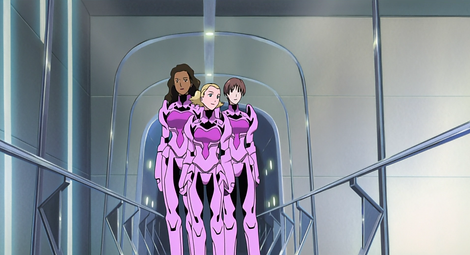


Pilot Walk View
A place where spectators have a clear view of the pilots as they make their way to the pit garage to board their IG mechs just before the race. Some people call it the "IG Paddock" because the pilots look like horses being sent to the starting line at a horse race.

Pit Garages
Garages set up next to the course. Teams competing in the IG-1 are given a dedicated pit garage for the duration of the season. At the start of every race, the pilots walk the IG mechs from their pit garage to the starting grid, which is a customary event to get people excited for the race.

Booths
These act as each team's command center, located above the pit garages. From here, the team can keep track of the race as a whole and monitor the status of the various parts of the mechs. In addition to giving instructions to the mechs, the team can communicate with staff in the pit and the Running Skeletons. In the corner of the room is an emergency access to the pit.

Running Skeletons
These are pit machines that allow for minor maintenance and parts replacement for the mechs while they are still advancing down the track so as not to interrupt the energy of the race. These vehicles enclose the mechs from both sides during each pit. The reinforced glass used on the outside of these panel-shaped vehicles allows the mechanics to be seen, helping to prevent any cheating during pit operations. This is how they got the name "The Running Skeletons". In the IG-1, each team's Running Skeleton is painted the same colors as the team's mechs.

Starting Grid
Grid positions are determined based on the previous year's results. To capture the force that accelerates the nearly 3-ton mechs to 400 km/h at the start of the race, starting blocks similar to those used in track and field events are set up on each grid.
Other Places & Things


Liz's Room
Liz's room sits on top of a hill, and to take advantage of the view, one wall of the room has a window with an automatic dimming mode. Although some flooring has been installed, the majority of the floor and the walls is poured concrete. The ceiling is over 3 meters high. She keeps her room simple, mainly with a bed, a desk, and a sandbag.

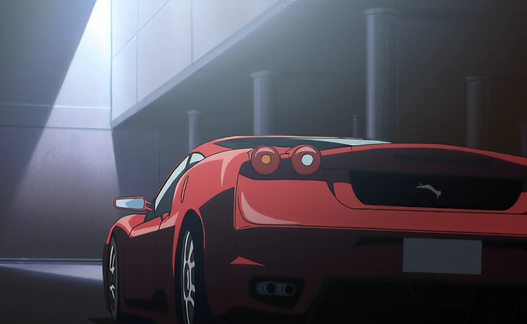
Michiru Satomi's Car
The engine is located in the center of the rear of the car, and the body is designed to be low to the ground. Even considering the fact that Team Satomi advanced to IG-1, it is a sports car so distinguished that it is hard to believe that it is a personal vehicle driven by the relatively young owner of a team. Incidentally, the emblem of the car is "Leaping Cat."


Max's Computer
The computer Max uses does not have a display like a regular laptop. So, she uses a head-mounted display as a monitor.


Multifunction Chairs
The three chairs that Team White Snow uses are located in a room that doubles as a meeting room for the pilots. Not only does each chair have a design that completely surrounds each pilot's body and can relax each pilot's mind, but each one also has a display placed inside to provide access to necessary information, should the pilots need to research something.
Spoilers Below
The following action report contains a spoiler revealed in episode 26 (the final episode) of the series.
Don't scroll down any further if you want to avoid spoilers!
Post IGPX Report: Team Satomi's Midfield Mech Design
A Closer Look: The New Team Satomi Midfield Mech Design Specifications Overview
What was the secret to Team Satomi's two-year championship in the IG-1? Let's take a closer look at the mech that Team Satomi is currently using. Here is a report as it was written when it was featured in the issue of IGPX World from March of 2046.

"The New Team Satomi Midfield Mech Design Specifications Overview (Draft)" that was the centerpiece article in a 2046 issue of IGPX World was based on leaked information from a confidential document on the real design specifications. Also, the document included the wording of "Overview (Draft)", so these are guidelines for the preliminary design and please understand that this may differ from the exact specifications of the final design.
Because we'll be verifying this specification document, we received support from TAKEUCHI, who owns the independent designer Industrial Garage listed on page 1. But, although TAKEUCHI acknowledges that there are many features in common with the mechs that Team Satomi runs now and the actual specifications, they unfortunately wouldn't comment on its complete authenticity. Nonetheless, that doesn't change the fact that this document has become crucial for knowing the process of the development of IG mechs. This document was written before 2044, when Team Satomi was still in the IG-2. It was in 2046 that Team Satomi began to use a design very similar to what's in the specification document in all three of their mechs at the same time. Remember that Team Satomi would conquer the IG-2 and move up to the IG-1 at the end of the very next year.
Design Studio - Industrial Garage
TAKEUCHI boasts an 80% share of the industrial robot market and owns a design team known for its IG mech designs for Team Velshtein. Team Satomi's Midfielder mech design was the third project for Industrial Garage, who is an independent designer established as a separate entity from the design team.
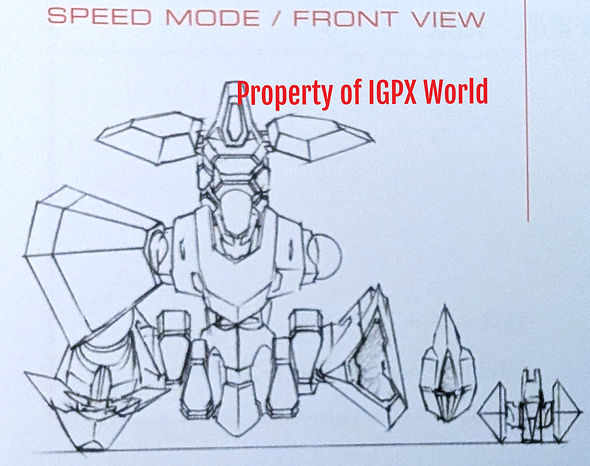
Background of Team Satomi's Implementation of the New Midfield Mech
In 2044, when this specification document was submitted, Team Satomi was in its fifth year of competing in the IG-2. If you only look at the fact that they made it to the finals in the IG-2 in 2040 and 2042, you might have said that they were an excellent team. But for Satomi Heavy Industries, the company that owns the team, the results of those two seasons were crucial. The fact is that they didn't actually win either of those two seasons. They managed to avoid being demoted to the IG-3 for the five years, but with the remarkable rise of new teams promoted from the IG-3 in the previous few years, they were definitely on the brink of demotion. So, they wanted to do something to get them through this trying period. So, the owner of Team Satomi, Michiru Satomi, decided to completely change the model of one of the team's IG mechs.
To prepare to order the new design, Team Satomi analyzed the race results of the past five years in detail. What they discovered was that they lacked the ability to analyze opposing teams. Even in cases where the difference in movement ability between the opposing team's mechs and theirs was not significant, they were unable to immediately grasp the habits that opposing teams used during races and it took more time than expected to analyze their formations. As a result, their responses to their opponent's movements were delayed, and points that did not need to be lost slipped out of their hands.

Normally, it is commonplace in the IGPX to develop and introduce three new mechs at the same time, and considering that the formation of the three mechs is the most important aspect of a team during a race, it is unthinkable to develop one mech without considering the balance between development and introduction of the mech into the team's playbook. However, Team Satomi was short on time. Pressure from Satomi Heavy Industries was increasing greatly day by day. Therefore, a model change for the Midfield mech, which was the core of the team and the mech that the team leader was piloting at the time, was given top priority.
The client for the new design was, surprisingly, an outside entity. This was the first time that Team Satomi had commissioned an independent design studio to design one of its mechs. Naturally, there was a great deal of opposition from Satomi Heavy Industries, which was also the owner and had its own IGPX development project office. In order to curb the opposition from the designer team, some of the designs that had been decided upon were later redesigned in-house. However, Team Satomi would later benefit greatly from having been able to outsource the work at that time. They won the IG-2 championship just two years after the introduction of their new Midfield mech. Then, when they were in their first IG-1 season in 2048, they became the first team to have the honor of becoming champions in their first season in the IG-1.

Team Satomi's Midfield Mech New Design Specifications (Draft)
The design specification document, spanning over 50 pages, is mainly separated into 3 parts: the specifications of the exterior, the specifications of how it controls, and the specifications of the engine. There are quite a few details that we want to share, but it would be boring to share all of them since most of the document is written using technical language, so we'll share a simple version of what the concepts and main points are.
1 The Basic Design and Standards
The design base is based on the standard used by TAKEUCHI, which is said to be the most popular. Care has been taken to ensure that no more labor than necessary was used in the procurement of common parts or in the production of parts. Though costs were cut, the company has aggressively introduced new materials and new plans for one-of-a-kind parts. The machine design is based on the "conic joint" advocated by O.F.P., a heavy machinery manufacturer that has influenced many IG mechs, and uses a design with sharp angles to create a stealth effect that is resistant to communication interference and interception. This sharp-edged design creates an integrated line between the upper and lower arms while in Speed Mode, which also helps to improve aerodynamics.

2 Device for Information Processing
Due to IGPX regulations, the DPE (data processing equipment) for information processing is installed on the side of the engine block, which is an area that is not directly exposed to where potential attacks could occur (likely attacks of a striking nature). In addition, the wing above the DPE is equipped with external sensors. In order to compensate for the weakness created by the adoption of a lightweight body, the "dodging ability" has been improved. In the cockpit, there is space for an optional Animal Navigation bay. The Animal Navigation system, which has been perfected in recent years, adds agility to the "dodging ability". It is also expected to dramatically improve the efficiency of accurate calculation of team formations and instructional operations for piloting.
3 Next-Generation Light Metal and A New Engine ("SIHOO42E")
A new generation of light metal is used not only for the exterior body, but also for the joint operating parts. Not only do these improve compatibility with the mainframe and drive capabilities, but these also make it possible to reduce the number of wires in each part by utilizing imprinting technology (integrating wiring patterns into the frame). The engine to be installed is assumed to be the SIHOO42E, manufactured by Satomi Heavy Industries. The basic performance is the same as last year's SIHOO42C, but the engine's 7.3% higher energy conversion rate and the synergistic effect of the "conic joint," which incorporates imprinting technology, will enable more nimble movement. In addition, speeds approaching those of Forward mechs can be expected even in Speed Mode. In order to respond to the recent acceleration in the diversification of racing tactics, the increased mobility and speed of Midfield mechs should become an essential factor.

4 The String-Egg System for Protecting Pilots
To protect the pilot from damage caused by the lightweight body, the cockpit employs the "String-Egg System," which is the latest technology. The "String-Egg System," which reduces interference from the mainframe by stretching wires inside the cockpit shell, is no different in terms of safety from the "Floating-Egg System," which uses a gel-like substance as a cushioning agent. However, it reduces the total weight of the mech by 2 to 3 kg.
Conclusion
About 15 months after the "Design Specifications" draft was written, Team Satomi revealed a new IG mech. It can be inferred that some polishing was done during that time, but the reason it took longer than usual was largely due to a problem in the Satomi Heavy Industries IGPX Development Project Office, whose pride was apparently hurt by having to outsource the mech design to an external party. It was the plant manager at the time, Ichi, who organized the project. According to TAKEUCHI, Ichi said this regarding the Inner Edge, which had been incorporated during the design phase: "If we don't incorporate this, I simply have no interest in making a mech that won't win." However, the Inner Edge was either cut down or the mech was able to achieve kinetic performance close to what was found in the "Design Specifications" draft. This was not a case of a company making something "half-baked", as Team Satomi would later prove by doing so well in the seasons after this new mech was revealed.
